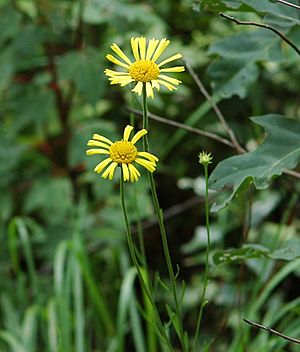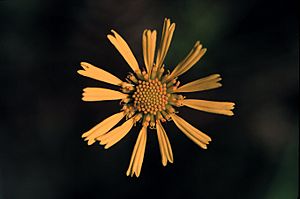Oneflower honeycombhead facts for kids
Quick facts for kids Oneflower honeycombhead |
|
|---|---|
 |
|
| Two Balduina uniflora flower heads, and one immature flower head. Photo credit: Larry Allain, U.S. Geological Survey | |
| Scientific classification | |
| Kingdom: | |
| (unranked): | |
| (unranked): | |
| (unranked): | |
| Order: | |
| Family: | |
| Genus: | |
| Species: |
B. uniflora
|
| Binomial name | |
| Balduina uniflora Nutt.
|
|
| Synonyms | |
Balduina uniflora is a cool plant from North America. People often call it the oneflower honeycombhead, savannah honeycombhead, or oneflower balduina. It belongs to the sunflower family, just like sunflowers and daisies!
This plant grows naturally in the southeastern United States. You can find it in states like Louisiana, Florida, Georgia, Alabama, Mississippi, South Carolina, and North Carolina.
Balduina uniflora is a perennial herb. This means it lives for more than two years. It has branching stems and usually grows 1 to 4 "flower heads." Each flower head has bright yellow ray florets (the petal-like parts) and many orange or yellow disc florets (the tiny flowers in the center). You can often spot this plant in wet pinelands, savannahs, and even along roadsides.
Contents
What Does This Plant Look Like?
The oneflower honeycombhead is a herbaceous plant. It can grow to be about 1 to 3 feet (0.4 to 1 meter) tall. It has strong, fibrous roots and stems that stand up straight. These stems often have small ridges and can branch out.
Its leaves are green and usually have soft hairs. They grow in an alternating pattern along the stem. The leaves tend to be grouped together near the bottom of the plant. They get smaller and more spread out as they go up the stem.
Like other plants in the sunflower family, what looks like one big flower is actually a group of many tiny flowers. This group is called a "flower head." At the bottom of this flower head, there are many green leaf-like parts called bracts. These form a bell or dome shape.
The yellow, petal-like parts are called ray florets. They don't produce seeds. The tiny flowers in the center are called disc florets. These are the ones that can produce seeds. Each disc floret has a yellow, two-branched part called a style that sticks out. The plant gets its name because the center of the flower head looks like a honeycomb when the fruits are ready.
After the flowers bloom, Balduina uniflora produces small, dry fruits. Each fruit has just one seed inside. These fruits are usually very tiny, about 1.3 to 2.2 millimeters long.
Growing This Plant
You usually won't find Balduina uniflora for sale in regular stores. However, you can grow it from seeds if you want to add it to a native wildflower garden. This plant loves wet, boggy soils. It also needs a lot of sunlight to grow well.
Where It Lives and Its Status
The oneflower honeycombhead is not currently listed as an endangered species. This means it's not in danger of disappearing.
NatureServe, an organization that tracks plants and animals, says this species is "Apparently Secure" across the country. However, it is considered "Vulnerable" in North Carolina and "Imperiled" in South Carolina. This means it needs a bit more attention in those two states.
This plant is not known to be an invasive species in any U.S. state. This is good news because invasive plants can harm local ecosystems.
Images for kids



